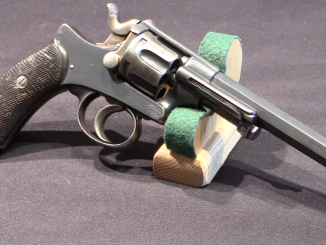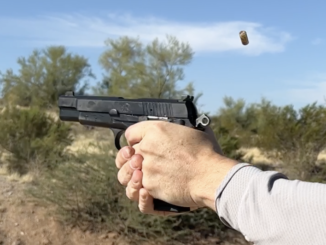FN played a role in the production of Polish wz.28 BARs, and in the process obtained a copy of the technical package for the weapon, and converted it to metric measurements. Under the supervision of Dieudonne Saive, this was used as the basis for FN’s own BAR production, called the Modelé 30. Production was done with a license from Colt, who owned the rights to Browning’s patents on the BAR.
The Model 30 was basically a Colt R75 (Model 1925), but incorporated a few improvements. Most significantly, the male and female parts of the gas system were swapped, which prevented carbon from building up and eventually jamming the gas piston. In addition, the bolt removal latch was improved form he US pattern, and the Polish wz.28 style rear sight was used. Lastly, a rate-reduction mechanism oil the fire control group gave the gun “slow” and “fast” settings, of roughly 350rpm and 600 rpm instead of the traditional semi and full auto settings.
Production began in 7.65mm, and the Belgian Army adopted the weapon, taking deliveries form 1930 until occupation in 1940. The Model 30 was also made in 8mm Mauser, and exported to China and Ethiopia. The design was fairly quickly supplanted in 1932 by the FN Modelé D, which added a quick-change barrel mechanism to the design, and this pattern sold more widely.




It’s always been a puzzle to me why the US didn’t make many of these improvements to the BAR on their own, just happy to issue the M1918A2, which while a decent Automatic Rifle in the A1 format, the A2 is one of those “neither fish, nor fowl…” affairs. I still find it baffling that they spent all that money on the M1, and did very little to improve the MG suite we went to war with… M1917 and M1919 were decent, but they were not state of the art in the late 1930s. Nor was the BAR, by any stretch of the imagination.
You have to wonder how many GIs we lost due to poor MG systems and inadequate doctrine. Ah, well… FN, at least, learned from all this, and we have the M240/MAG58 to show for it, the final expression of John Browning’s genius and Saive’s adaptations of it.
Kirk:
Apart from bureaucratic inertia, I can only imagine that money, or the lack thereof, must have been behind it. A lot must have been spent on the development of the M1 rifle. Since the existing machine guns worked well enough, I doubt there was much will to change them.
I have always found the M1919A4 a bit of an anomaly. The US Army classed it as a light machine gun, but it is not an LMG as we would understand it. Obviously, compared to the M1917 it is light and portable, and so enables firepower to be brought to bear quite quickly. So the rifle platoon would have automatic fire from the BAR, backed up by the M1919A4 at the company level. The powers that were must have thought that, given budgetary constraints, this would do. When WWII came along, the budgetary constraints were no more, but it would have been no time to start making Bren guns. The mix of BARs and M1919A4s, allied to a semi-automatic rifle, seems to have given American soldiers sufficient firepower for the time.
I’ve always had problems with the dual rate of automatic fire vs. semi-auto and full-auto thing.
Even allowing for firing from an open bolt, the M1918 was pretty accurate firing off the bipod or a rest on single-shot. The dual rate autofire setup basically gave you the choice of “Difficult to control” at 350 R/M and “Pretty much uncontrollable” at 750.
Ideally, the BAR should have had the same setup as the later FG42. Closed bolt on single-shot, open-bolt on full-auto. Plus a RoF that was in the range of the resonance frequency of the action, which would have been about 450-500 R/M.
The moral is “Machine rifles are not light machine guns, and vice versa”.
clear ether
eon
“(…)had problems with the dual rate of automatic fire(…)”
You seems to be aligned in your view with USMC as according to https://www.militaryfactory.com/smallarms/detail.php?smallarms_id=58
Marine units were also issued the type but favored the original’s single-shot functionality and, therefore, reverted their actions back to single / full modes of fire